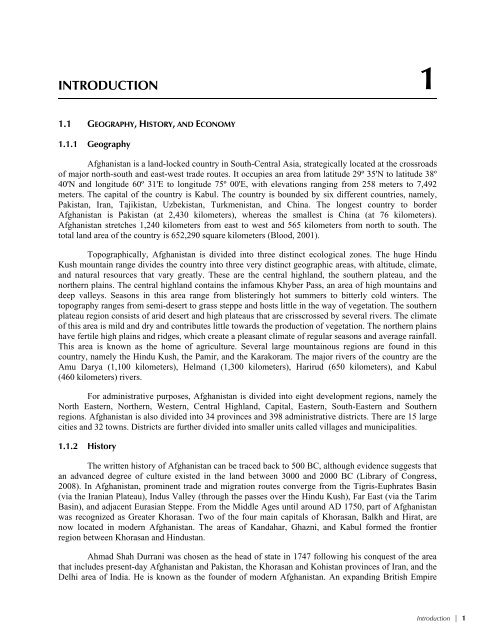Afghanistan Mortality Survey 2010 - Measure DHS
Afghanistan Mortality Survey 2010 - Measure DHS
Afghanistan Mortality Survey 2010 - Measure DHS
- No tags were found...
Create successful ePaper yourself
Turn your PDF publications into a flip-book with our unique Google optimized e-Paper software.
INTRODUCTION 11.1 GEOGRAPHY, HISTORY, AND ECONOMY1.1.1 Geography<strong>Afghanistan</strong> is a land-locked country in South-Central Asia, strategically located at the crossroadsof major north-south and east-west trade routes. It occupies an area from latitude 29º 35'N to latitude 38º40'N and longitude 60º 31'E to longitude 75º 00'E, with elevations ranging from 258 meters to 7,492meters. The capital of the country is Kabul. The country is bounded by six different countries, namely,Pakistan, Iran, Tajikistan, Uzbekistan, Turkmenistan, and China. The longest country to border<strong>Afghanistan</strong> is Pakistan (at 2,430 kilometers), whereas the smallest is China (at 76 kilometers).<strong>Afghanistan</strong> stretches 1,240 kilometers from east to west and 565 kilometers from north to south. Thetotal land area of the country is 652,290 square kilometers (Blood, 2001).Topographically, <strong>Afghanistan</strong> is divided into three distinct ecological zones. The huge HinduKush mountain range divides the country into three very distinct geographic areas, with altitude, climate,and natural resources that vary greatly. These are the central highland, the southern plateau, and thenorthern plains. The central highland contains the infamous Khyber Pass, an area of high mountains anddeep valleys. Seasons in this area range from blisteringly hot summers to bitterly cold winters. Thetopography ranges from semi-desert to grass steppe and hosts little in the way of vegetation. The southernplateau region consists of arid desert and high plateaus that are crisscrossed by several rivers. The climateof this area is mild and dry and contributes little towards the production of vegetation. The northern plainshave fertile high plains and ridges, which create a pleasant climate of regular seasons and average rainfall.This area is known as the home of agriculture. Several large mountainous regions are found in thiscountry, namely the Hindu Kush, the Pamir, and the Karakoram. The major rivers of the country are theAmu Darya (1,100 kilometers), Helmand (1,300 kilometers), Harirud (650 kilometers), and Kabul(460 kilometers) rivers.For administrative purposes, <strong>Afghanistan</strong> is divided into eight development regions, namely theNorth Eastern, Northern, Western, Central Highland, Capital, Eastern, South-Eastern and Southernregions. <strong>Afghanistan</strong> is also divided into 34 provinces and 398 administrative districts. There are 15 largecities and 32 towns. Districts are further divided into smaller units called villages and municipalities.1.1.2 HistoryThe written history of <strong>Afghanistan</strong> can be traced back to 500 BC, although evidence suggests thatan advanced degree of culture existed in the land between 3000 and 2000 BC (Library of Congress,2008). In <strong>Afghanistan</strong>, prominent trade and migration routes converge from the Tigris-Euphrates Basin(via the Iranian Plateau), Indus Valley (through the passes over the Hindu Kush), Far East (via the TarimBasin), and adjacent Eurasian Steppe. From the Middle Ages until around AD 1750, part of <strong>Afghanistan</strong>was recognized as Greater Khorasan. Two of the four main capitals of Khorasan, Balkh and Hirat, arenow located in modern <strong>Afghanistan</strong>. The areas of Kandahar, Ghazni, and Kabul formed the frontierregion between Khorasan and Hindustan.Ahmad Shah Durrani was chosen as the head of state in 1747 following his conquest of the areathat includes present-day <strong>Afghanistan</strong> and Pakistan, the Khorasan and Kohistan provinces of Iran, and theDelhi area of India. He is known as the founder of modern <strong>Afghanistan</strong>. An expanding British EmpireIntroduction | 1








![Obtaining Informed Consent for HIV Testing [QRS4] - Measure DHS](https://img.yumpu.com/49850117/1/190x245/obtaining-informed-consent-for-hiv-testing-qrs4-measure-dhs.jpg?quality=85)








